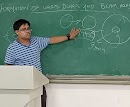Quantum Harmonic Oscillator Part-4: The Series Solution of Schrödinger’s Equation Quantum Harmonic Oscillator Potential
Okay…without any
further delay let’s just start…
The objective of this article is to find a general solution for the harmonic oscillator by finding
the series solution.
From the equation 7 of
my last article, we obtained an expression, and to solve Schrodinger’s equation
for this problem, we wish to explicitly build in knowledge of the exponential
asymptotic behaviour of ψ that was established in previous article.
So, there is a one way
to do so, that is by assuming that can be expressed as the product of two
functions, one which will have the asymptotic behaviour of wavefunction and
other one is an unknown function, lets say it as H(ξ). We can express what we said as follows,
ψ(ξ) = H(ξ) e^(-ξ²/2) (1)
This is just an
assumption for the solution taken by only trial and error method. We have to
see whether it satisfies our conditions or not.
From elementary
calculus we know that any function of x ( here, ξ) can be expressed as an infinite polynomial using Taylor or McLaurin
Series, so,
H(ξ) = a₀
+ a₁ ξ + a₂ ξ² + … = ∑n an ξⁿ [n ranges from 0 to ∞] (2)
Here, n ranges from 0 because we cannot
have negative powers for ξ as it would lead to infinities, which in this
case will lead to not normalizable.
Now, we have to solve Schrodinger’s
equation for harmonic oscillator that is equation 11 of part-2 article this
this series of QHO.
d^2 ψ / d ξ^2
+ ( λ – ξ^2) ψ = 0 (3)
Differentiating
equation 1 we get, we get,
d² ψ / d ξ² = [ d²H/d ξ² - 2ξ dH/dξ + ( ξ² - 1)H ] e^(-ξ²/2) (4)
Note that we have
dropped the explicit dependence of H on ξ for sake of clarity.
Now, substituting
equation 4 and equation 1 in equation 3, we get,
d²H/d ξ² - 2ξ dH/dξ + (λ - 1) H = 0 (5)
Now, we have
everything in our hands to attempt a series solution for H(ξ). So, by differentiating equation 2, we get,
dH/dξ = ∑n nan ξⁿ⁻¹ [n ranges from
0 to ∞] (6)
again differentiating,
d²H/d ξ² = ∑n n(n-1)an ξⁿ⁻² [n ranges from 0 to ∞]
(7)
Substituting equation 2, 6 and 7 in
equation 5, we get,
∑n n(n-1) an ξⁿ⁻² +
∑n (λ -1-2n) an ξⁿ = 0 [n ranges
from 0 to ∞] (8)
Dealing with equation 8 will be hard as
expanding out the sums would give contributions of the form ξⁱ from both terms for i ≥ 2 and thus resulting into not all terms
having same power in ξ collected together. This
can be solved. Let’s see how…
Firstly, see that the first sum will be
equal to 0 if n=0 or 1, so, we can write as follows,
∑n n(n-1) an ξⁿ⁻² = 0 + 0 + ∑n n(n-1) an ξⁿ⁻² (9)
Where, last term of RHS having n ranges
from n=2 to ∞ and in the term of LHS, n ranges from n=0 to ∞.
What we see in equation 9 is that,
here, n is a dummy index, which means that because the sum runs over all
possible integral values which are greater than 0 up to ∞, it is clearly
irrelevant what label is actually assigned to index of summation. In short, we
can change or transform the index as we wish we solve the equation easily. So,
let’s consider i = n – 2,
to solve the problem we discussed two paragraphs above. Now equation 9 converts
into,
∑n n(n-1) an ξⁿ⁻² = ∑ᵢ (i+2) (i+1) ai+2 ξⁱ (10)
Where, in the term of LHS, n ranges
from n=0 to ∞ and in the term of RHS, i ranges from i=0 to ∞
Now, in equation 10 both n and i are
dummy indexes, so, we can define n=i,
∑n n(n-1) an ξⁿ⁻² = ∑n (n+2) (n+1) an+2 ξⁿ (11)
If you have a doubt on equation 11,
then just expand the equation on both sides, you will find they are absolutely
identical.
So, now we have solved our problem
which I discussed a few paragraphs above and thus now from equation 8 and 11,
∑n {(n+2) (n+1) an+2 + (λ -1-2n) an} ξⁿ = 0 [n ranges from 0 to ∞]
(12)
From, equation 12 we can see that the
terms inside the curly braces are pure numbers and don’t have any dependence on
ξ. Also, the whole sum results in 0, and from our knowledge we
know that in general, ξ is not equal to 0, but
still, the sum is 0. The only way this can happen if every term inside curly
braces vanishes, so this can be achieved by,
an+2 = {(2n+1- λ)/(n+2) (n+1)} an+2 (13)
Now, from our knowledge from series
solution theory, we know that equation 13 is called as a recursion relation as
it specifies a given expansion coefficient recursively in terms of the
preceding coefficient in the series. So, we need to find a₀ and a₁ terms only and then we can find the even and odd terms on the
basis of a₀ and a₁ respectively.
Before we progress further, I want to
remind you guys that we have a boundary condition that is the wavefunction must
be finite as ξ tends to ±∞. So, in the equation
1, we know that e^(-ξ²/2) is convergent as we derived that in this way in our part-3
article on asymptotic solution. Thus, as long as H(ξ) is convergent or at worst case, if it diverges
no more strongly than the exp(+ξ²/2), then the overall solution will remain convergent.
But, unfortunately, if
you consider a general series expansion of then you will find it behaves
asymptotically like exp(2ξ²). General series
expansion of exp(ηξⁱ),
exp(ηξⁱ) = 1 + ηξⁱ + η²ξ²ⁱ/2! + η³ξ³ⁱ/3! + …
(14)
Now, from equation 2
and 13,
Term(n+1) / Term(n) = (an+2 / an) ξ² = {(2n+1- λ)/(n+2) (n+1)} (15)
And the ratio of successive terms in
the exponential function of equation 14,
Term(n+1) / Term(n) = ηξⁱ/(η+1) (16)
Equation 15 and 16 at
n tends to ∞,
Term(n+1) / Term(n) ~ 2 ξ²/n (17)
And,
Term(n+1) / Term(n) ~ ηξⁱ/n (18)
On comparing equation
17 and 18, we get, η=2 and i=2. Thus, we conclude that harmonic
oscillator solution behaves as an exponential of the form exp(ηξⁱ) =
exp(2ξ²). This means that we can represent wavefunction
as,
ψ(ξ) = H(ξ) e^(-ξ²/2) ~ e^(2ξ²) e^(-ξ²/2) ~ e^(3ξ²/2)
(19)
Equation 19 is clearly
divergent and non-normalizable. The only way to solve this problem and prevent
this catastrophe is to prevent the series for H(ξ) from going to an infinite number of terms. Thus, terminating the
series of H(ξ) after a finite number of terms.
So, if the highest
power of ξ appearing in H(ξ) is n, and if all aᵢ = 0 for i>n, then from
the recursion relation (equation 13),
λ = 2n+1
So, from above equation and equation 2
and 10 from Part-2 article that is Schrödinger’s Equation with Dimensionless Terms, we can find the
energy corresponding to quantum number n:
λ = 2n+1 = 2E / ħω
or,
E = (n+1/2) ħω = (n+1/2) ħ(√k/m), n=1,2,3,4,… (20)
From equation 20, we can see that E is
proportional to n, which indicates that the harmonic potential energy levels
are equally spaced. These equally spaced energy levels are known as vibrational
levels as the harmonic potential mimic the attractive forces between the
molecules.
Apart from these, if
you observe a spectrum then you will find that molecular spectra exhibit lines
between the equally spaced vibrational transitions. These are called rotational levels. I will someday write a brief article on this topic.
So, that’s it, if you
survived till the last then congrats as not as many people can do so. In my
next article, which will be part-5 in this series, I will write on Hermite Polynomials and Quantum Harmonic
Oscillator Wavefunctions. So, stay tuned for that. Once it is uploaded, the
link will be available here.
Thanks for Reading!!!
-Ratnadeep Das Choudhury












0 Comments